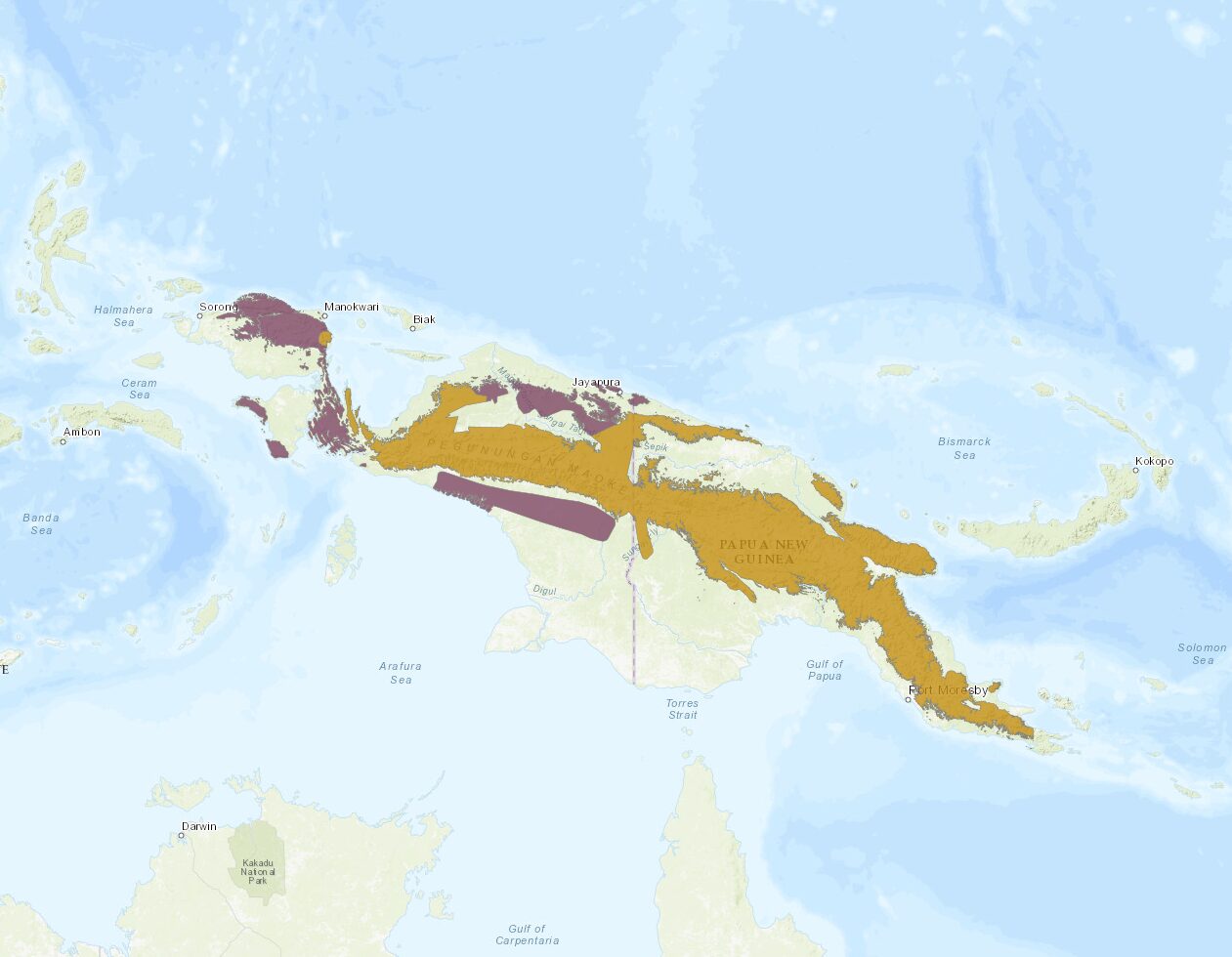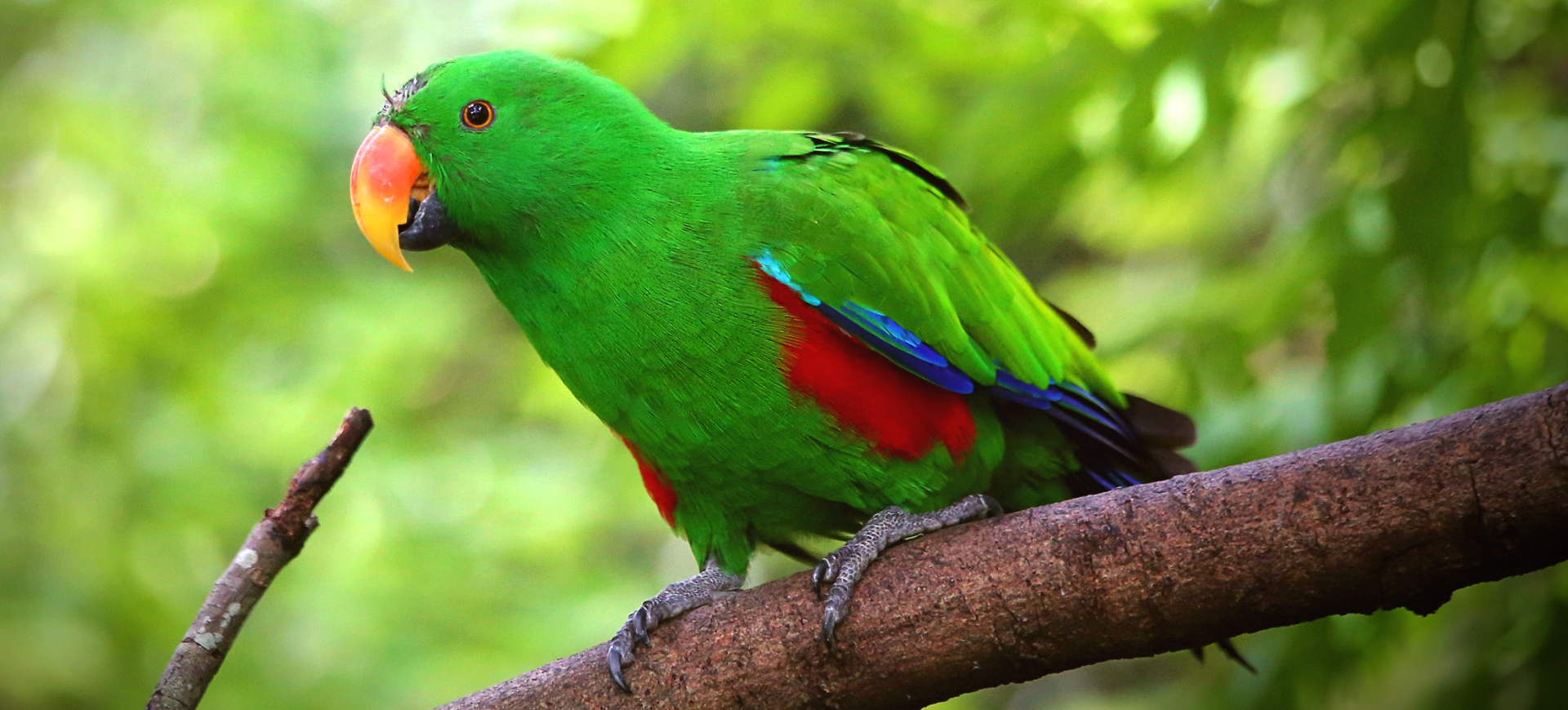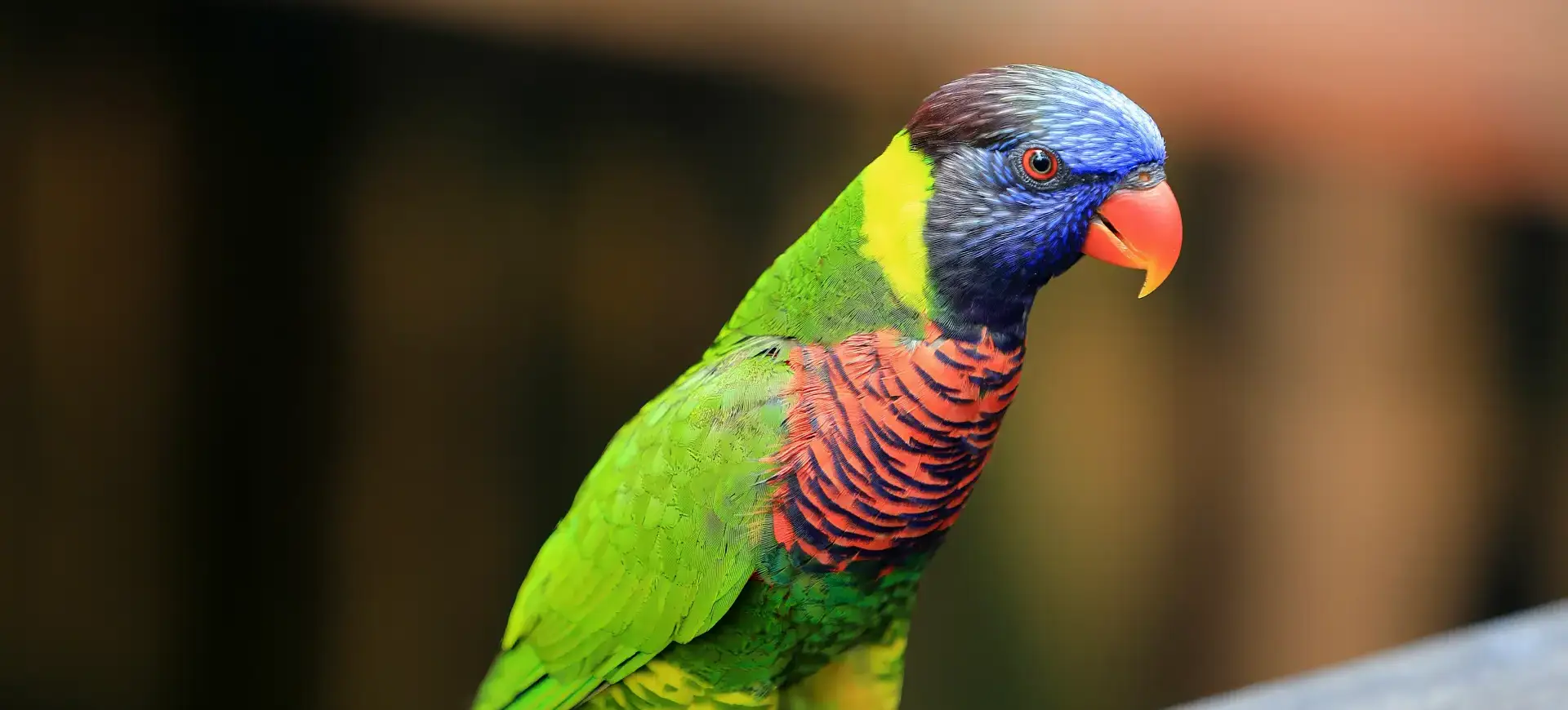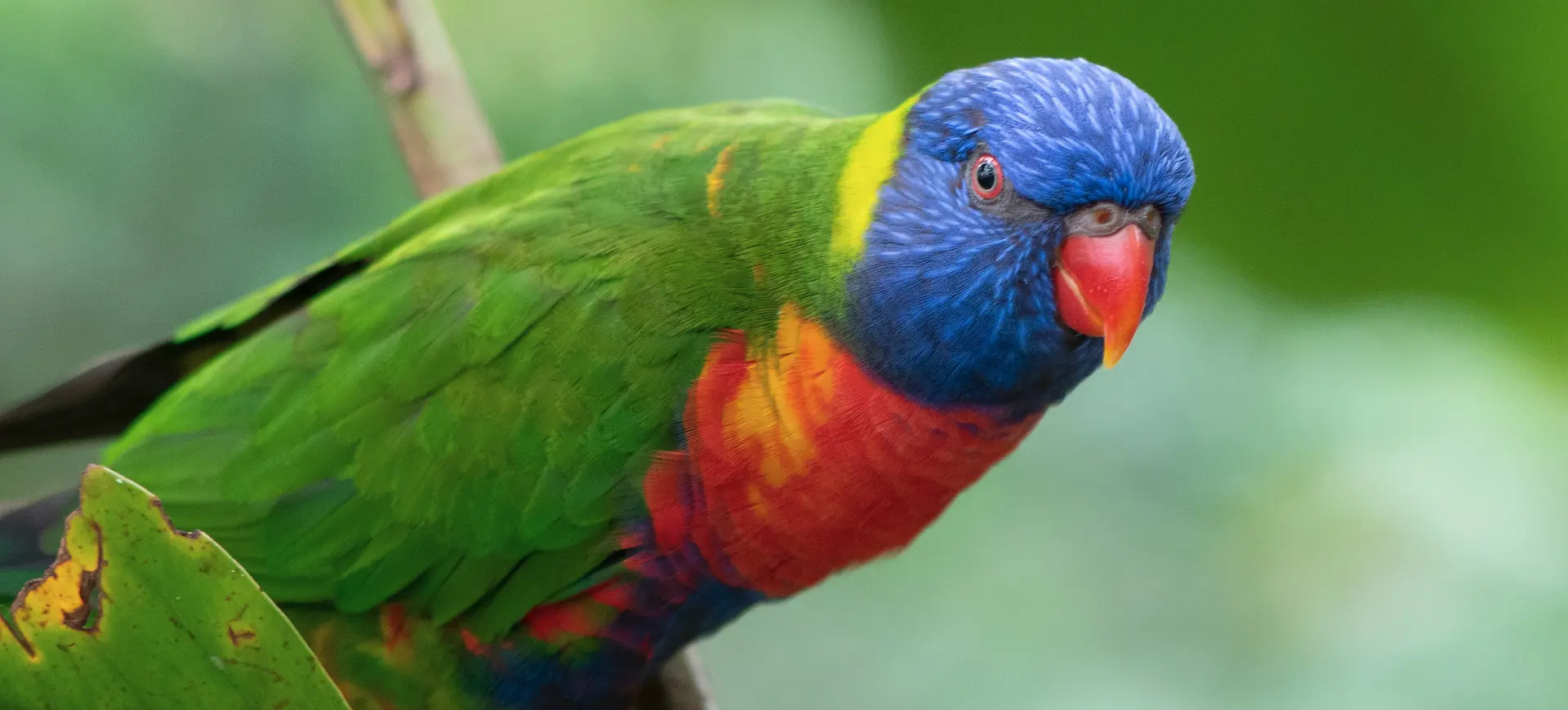Overview
Pesquet’s Parrot, also known as the Dracula Parrot, is a striking bird native to the rainforests of New Guinea. This species stands out due to its predominantly black and grey plumage, with a vivid splash of red under its wings and tail, contrasting sharply against the dark feathers. Unlike most parrots, Pesquet’s parrot has a nearly featherless face, which is thought to prevent feather matting from a diet rich in sticky fruit. This bird is one of the larger parrot species, exhibiting a strong, hooked beak designed for breaking into hard fruit skins, specifically figs, which form the bulk of its diet.
Adapted to life in the canopy, Pesquet’s Parrot is a strong flier with broad wings that allow it to travel considerable distances in search of fruiting trees. It is relatively solitary or seen in pairs, though groups may gather in areas with abundant food sources. The Parrot’s distinct vocalizations can often echo through the forests, a mix of squawks and whistles that communicate between individuals. Despite its robust appearance, the species faces threats from habitat loss and hunting, primarily for its striking plumage, leading to a decline in its population.
The ecology of Pesquet’s Parrot is closely tied to the health of its rainforest habitat, relying on a variety of fruit-bearing trees for sustenance. This diet makes thParrotot an important seed disperser, contributing to the regeneration of its forest environment. The bird’s feeding habits are a remarkable display of adaptation, using its strong beak to skillfully remove fruit pulp and access seeds. Conservation efforts are crucial to protect this unique species, with initiatives focused on habitat preservation and anti-poaching measures to secure its future.
Taxonomy
Kingdom
Phylum
Class
Order
Family
Genus
Species
Type
Current distribution:
Pesquet's Parrot is found exclusively in New Guinea, with its range covering the island's Indonesian and Papua New Guinean sections. Despite this broad distribution, the species is rare due to habitat loss and hunting pressures. The bird's presence is often fragmented, found in pockets of suitable habitat that remain intact amid areas of deforestation.
Conservation measures, including the establishment of protected areas and the enforcement of hunting regulations, are crucial for the preservation of Pesquet's Parrot's natural habitats. These efforts aim to mitigate the impacts of human activity, including logging and agricultural expansion, which threaten the rainforests of New Guinea. Ongoing research and monitoring are necessary to understand the Parrot's ecological needs and implement effective conservation strategies to ensure its survival in the wild.
Physical Description:
Pesquet’s Parrot is notable for its distinctive featherless face and deep black color, starkly contrasting its bright red and black plumage. The red patches are found under the wings and on the tail, making the bird easily identifiable against the green backdrop of its rainforest habitat. This Parrot’s body is robust and suited to its arboreal lifestyle, with strong legs and claws for gripping branches as it moves through the canopy. The large, curved beak is a tool for consuming its fruit-based diet and serves as a defense mechanism against potential threats.
The sexual dimorphism in this species is subtle, with females having a slightly more extensive red patch on their underwing and tail. Juveniles resemble adults but have a duller overall appearance, with their distinctive facial and plumage characteristics developing as they mature. The bird’s wings are broad and powerful, designed for efficient flight over the forest canopy, allowing it to glide and maneuver easily. Pesquet’s Parrot’s overall appearance is not just a result of evolutionary adaptation to its diet and habitat but also makes it a target for poaching due to its unique and striking feathers.

Lifespan: Wild: ~20 Years || Captivity: ~40 Years

Weight: Male & Female: 1.5-1.8 lbs (680-800 g)

Length: Male & Female: 18-20 in (46-51 cm)

Wingspan: Male & Female: 9-10 in (23-25 cm)

Top Speed: 30 mph (48 km/h)
Characteristic:
Native Habitat:
Pesquet’s Parrot is endemic to the primary and secondary rainforests of New Guinea, thriving in the dense, humid environments that characterize this region. These rainforests provide the fruiting trees that form the basis of the Parrot’s diet and offer nesting sites. The species is particularly associated with mountainous areas, which can be found at elevations of up to 1,800 meters, although it is also present in lowland regions.
The bird’s habitat preference makes it vulnerable to deforestation and habitat degradation, exacerbated by the expanding human footprint. Conservation of these rainforest areas is critical for the survival of Pesquet’s Parrot, as these environments are home to a rich biodiversity that includes many other endemic species. Efforts to protect and restore these habitats are essential for maintaining the ecological balance and ensuring the continued presence of this unique in New Guinea’s forests.
Climate Zones:
Biomes:
WWF Biomes:
Biogeographical Realms:
Countries:
Diet:
Diet & Feeding Habits:
Pesquet’s Parrot primarily feeds on figs, most of its diet, and other soft fruits. This specialized diet has influenced much of the bird’s physical evolution, including its featherless face, which helps prevent the sticky fruit pulp from matting its feathers. The bird’s strong beak is adept at tearing open fruit to reach the pulp and seeds, indicating a well-adapted feeding mechanism. Pesquet’s Parrot plays a significant role in its ecosystem as a seed disperser, contributing to the health and regeneration of its rainforest habitat.
These parrots are often observed feeding in the canopy, where their diet of figs and other fruits provides essential nutrients. Their feeding behavior is characterized by a preference for ripe fruit, which they can skillfully pluck from branches using their beaks and feet. Pesquet’s Parrot’s dependency on fruiting trees for food highlights the importance of preserving their natural habitats. The loss of fruit-bearing trees due to deforestation poses a significant threat to their survival, emphasizing the need for conservation efforts focused on habitat protection.
Mating Behavior:
Mating Description:
Pesquet’s Parrot is believed to be monogamous, with pairs forming strong bonds maintained throughout the breeding season and possibly beyond. Nesting typically occurs in tree cavities, where the female lays a small clutch of eggs that she incubates while being fed by the male. This nesting strategy protects the eggs from predators and facilitates temperature regulation within the nest.
The breeding season is aligned with the availability of food resources, ensuring ample nourishment for the female and the upcoming chicks. Parental investment is high, with both parents involved in feeding and caring for the young until they are ready to fledge. The fledging period is a critical time for the chicks as they learn to fly and forage under the guidance of their parents. Conserving Pesquet’s Parrot’s habitat is vital for providing suitable nesting sites and enough food resources to support successful breeding and chick rearing.
Reproduction Season:
Birth Type:
Pregnancy Duration:
Female Name:
Male Name:
Baby Name:
Social Structure Description:
Pesquet’s Parrot exhibits a relatively solitary lifestyle. Individuals are typically seen alone or in pairs, though they may form small groups when feeding. The social bonds between mating pairs are strong, with pairs engaging in mutual grooming and sharing food. These behaviors strengthen pair bonds and play a role in communication and social cohesion among these parrots.
The social structure of Pesquet’s Parrot is adapted to its arboreal habitat and frugivorous diet, with social interactions often centered around food sources. The Parrot’s vocalizations serve as a means of communication between individuals, facilitating social interactions and warning of potential threats. Understanding the social dynamics of Pesquet’s Parrot is important for conservation efforts, providing insights into their behavioral ecology and the impacts of environmental changes on their social behavior.
Groups:
Conservation Status:
Population Trend:
The population of Pesquet’s Parrot is under threat due to a combination of habitat loss and hunting. The species’ reliance on large tracts of rainforest means that deforestation for timber extraction and agricultural expansion directly impacts its ability to survive and reproduce. Hunting for feathers and for the pet trade further reduces their numbers, making conservation efforts increasingly important.
Efforts to protect Pesquet’s Parrot focus on habitat preservation and enforcing hunting bans. Educating local communities about the species’ ecological role and the importance of conservation can help reduce hunting pressures. Establishing protected areas encompassing key habitats is crucial for the parrot’s survival, providing safe havens where populations can stabilize and potentially increase.
Population Threats:
The primary threats to Pesquet’s Parrot include habitat destruction due to logging and agricultural development, which reduces the availability of food and nesting sites. Hunting for feathers, used in traditional ceremonies and for the pet trade, poses a significant risk despite legal protections. The bird’s specialized diet and habitat preferences make it particularly vulnerable to these threats, highlighting the need for targeted conservation strategies.
Climate change also threatens Pesquet’s Parrot, potentially altering the distribution and availability of fruiting trees. Addressing these challenges requires a comprehensive approach, including habitat protection, sustainable land-use practices, and community engagement in conservation efforts. The future of Pesquet’s Parrot depends on the effectiveness of these measures in mitigating the impacts of human activity on its rainforest home.
Conservation Efforts:
Conservation initiatives for Pesquet’s Parrot include habitat protection through establishing national parks and reserves, which safeguard critical rainforest areas. Anti-poaching measures and strict enforcement of wildlife trade regulations are also essential to protect the parrot from illegal hunting and capture. Community-based conservation programs that involve local people in protecting their natural heritage can effectively reduce threats to the species.
Education and awareness campaigns play a key role in conservation efforts, raising public understanding of the parrot’s plight and the importance of preserving its habitat. Research into the species’ ecology and breeding biology is crucial for informing conservation strategies and ensuring their success. International cooperation is necessary to address the cross-border challenges of habitat conservation and wildlife trade, ensuring a coordinated approach to protecting Pesquet’s Parrot.
Additional Resources:
Fun Facts
- Pesquet’s Parrot is one of the few parrot species with a nearly featherless face, an adaptation to its sticky fruit diet.
- Due to its distinct appearance, it has earned the nickname “Dracula Parrot.”
- This species is highly specialized in its diet, predominantly feeding on figs and other fruits.
- The vivid red patches on its wings and tail stand out against its dark plumage, making it one of the most visually striking parrots.
- Pesquet’s Parrot plays a crucial role in its ecosystem as a seed disperser for fruit trees.
- It is one of the larger parrot species, with a strong and curved beak adapted to its frugivorous diet.
- Despite its powerful appearance, the Parrot is vulnerable to habitat loss and hunting.
- Conservation efforts are focused on habitat preservation and reducing hunting pressures.
- The bird’s unique vocalizations can be heard echoing through the rainforests of New Guinea.
- Education and community involvement are key to preserving Pesquet’s Parrot, highlighting the importance of protecting New Guinea’s rich biodiversity.











